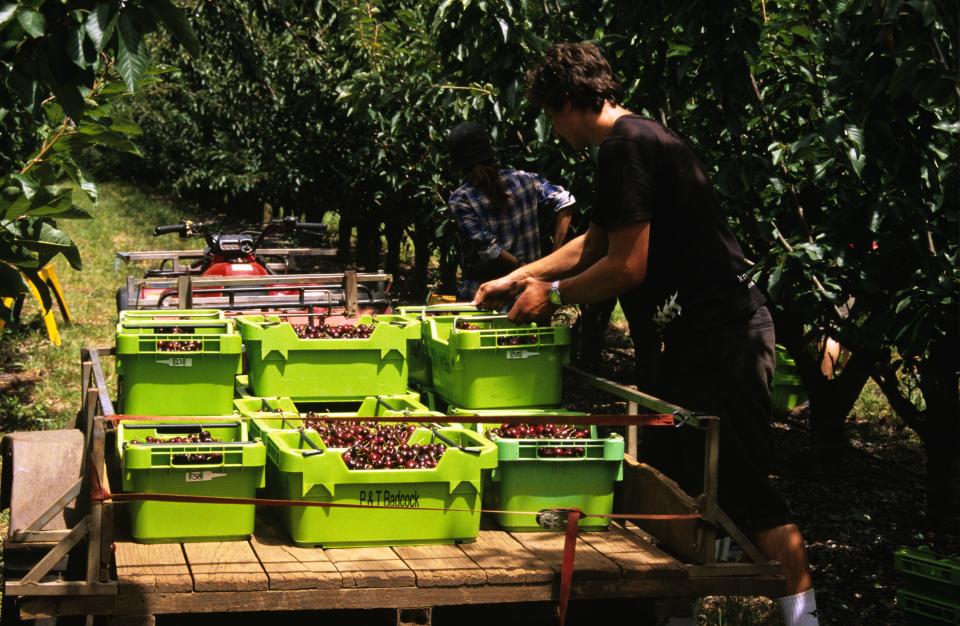$5.50 blueberries, $28 cherries: Why supermarket prices could shoot up

The cost of blueberries, cherries, cereals and other fruits and vegetables could rise due to a severe labour shortage, a peak farming association has warned.
Seasonal jobs picking fruit and vegetables that are usually filled by thousands of backpackers on working visas are vacant due to the international travel ban in place since 18 March.
“We usually have about 160,000 backpackers – we’re now down to 60,000, [who have] been given extensions of their visas. So they're running around, doing the job of 160,000,” NSW Farmers Association president James Jackson told Yahoo Finance.
“There's a huge labour shortage in all sorts of areas in agriculture at the moment.”
The Australian horticulture industry alone, which supplies fruits, vegetables, nuts, and flowers, is expected to be 26,000 workers short by March 2021.
In a bid to reduce the worker shortage, visa holders and those on working holiday visas have been granted a 12-month extension on their stay in Australia to work for approved employers.
But Jackson pointed to cereal, tomatoes, blueberries, cherries and even sheep shearing as areas that are struggling for workers.
Some areas like the cereal harvest and cherries will “muddle through”, with the help of truck drivers, pensioners and even pilots.
But produce like cherries and blueberries could go unpicked, Jackson said.
Cherries, which have also been impacted by hail damage, could go “up $5 a kilo”. Cherries at Coles are currently $7 per 300 gram, or $23.30 per kilo; the surge could bring them to $28.30 per kilo.
However, the NSW Farmers president believes they’ll fare better than blueberries.
“Certainly blueberries up on the north coast of NSW – that is a real touchpoint at the moment. An [employer] usually has 700 pickers and now he’s got 70.”
Blueberries are also more difficult to pick than cherries, as it requires more dexterous fingers, according to Jackson, meaning some workers could be less suited for the job – and all of this could lower the supply of blueberries and push prices up.
While Jackson said it was difficult to put a figure on how much blueberries could rise by, it could be around “an extra dollar a punnet”.
At the time of publishing, Driscoll’s blueberries from Coles were going for $4.50 a 230g punnet.
“It’s bad for the country, it's bad for the farmers, it's bad for the economy,” he said.
Aussies urged to take up farm jobs
A week ago, the Federal Government announced a $6,000 cash incentive to cover relocation costs, including accommodation and travel, for Aussies heading to regional areas for farm work.
“There are currently thousands of positions vacant on farms across the country, including picking mangoes in the Northern Territory, harvesting wheat in the WA Wheatbelt and picking cherries in Young,” said National Farmers’ Federation CEO Tony Mahar.
“From pickers and pruners to plant operators, there is something to suit a wide variety of job seeker.
“Farmers require people who are reliable, enthusiastic and energetic – if you tick these boxes, you’ll very likely have what it takes to be a valued member of a farm’s workforce,” he said.
According to Jackson, you can earn roughly $200 to $300 a day picking fruit.
But only 8 per cent of horticultural crop pickers are Australian, he said, adding that seasonal jobs don’t appeal to most Aussies who want more permanency.
In Cairns and Wide Bay respectively, 20,000 people are on JobSeeker – but 15,000 seasonal workers are needed in these areas.
But Jackson said the doubled JobSeeker rate wasn’t the only reason why Australians weren’t flocking to farm work.
“The reality is that … accessing Australian labour has been a problem even prior to the jumping up of the jobseeker rate,” he told Yahoo Finance.
NSW Minister for Agriculture Adam Marshall previously said he wanted to see more Australians “jump off the couch” and “get out into the regions where there’s plenty of good-paying work on until the end of the year.”
But this is sending the wrong message, Jackson believes.
“Jumping on a theme that Australians are too lazy to do it’ is not going to work for us. We want those people who can do it, and are happy to do it, and they'll help us,” he said.
Even children can pitch in to help, too, he added.
“Schoolkids over Christmas [can do it too]. One guy’s ten year old grandson was earning $250 a day picking cherries,” he said.
“It’s pretty good pocket money.”
Want to get better with money and investing in 2021? Sign up here to our free newsletter and get the latest tips and news straight to your inbox.
Follow Yahoo Finance Australia on Facebook, Twitter, Instagram and LinkedIn.

 Yahoo Finance
Yahoo Finance 
